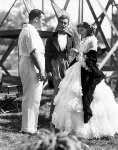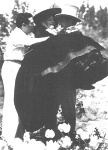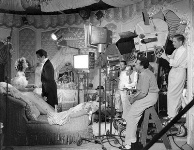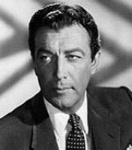| Robert Taylor
(Camille)

- by Néstor G. Acevedo (Greg) - |
|
INTRODUCTION |
Robert Taylor (1911-1969) was the last of the matinée idols and was under contract to MGM for twenty five (25) years, longer than any other major star. Born in Filley, Nebraska, on august 5, 1911, with the memorable name Spangler Arlington Brough. Early in his career, he was know as “the man with the perfect profile” clean cut and strikingly handsome with wavy dark hair, and blue eyes. Robert Taylor with a classic profile, he was an instant heart-throb from his first film appearance.
THE BEGINNING OF A BIG STAR |
Robert Taylor went to drama school in 1933 but before he could follow through on the plan an MGM talent scout spotted him and gave him both a contract and a new name. By his own admission, he was hardly the greatest actor of his generation but his many directors and famous co-stars always found him a most professional actor, always on time and willing to work hard to get the film to be the best. Robert Taylor began as an MGM contract star in 1934, but his first film Handy Andy, was made at Fox. His heyday as a ladies- man was in the late 30s, when he squired Irene Dunne in Magnificent Obsession, Greta Garbo in Camille, Barbara Stanwyck (whom he later married) in, His Brother's Wife, and Joan Crawford in, The Gorgeous Hussy, and Waterloo Bridge with Vivien Leigh, He was teamed with Eleanor Powell in Broadway Melody of 1936, but it was Magnificent Obsession that really made him a big star, and favorite of female moviegoers. He was nicely American in The Yank of Oxford, even better in love with Margaret Sullavan in Three Comrades, and quite adequate in action pictures, Ivanhoe with Elizabeth Taylor and Bataan among others.
GARBO AND TAYLOR IN CAMILLE |
A Los Angeles newspaper as Camille went into production, and Thalberg (the boy Wonder of MGM) enthused to Frances Marion about the pairing of Garbo and Taylor: “we can't miss with these two!” With only three year's experience in front of the camera, the twenty four (24) years old Taylor was not so sure. “I was scared to death at the thought of appearing with Garbo in Camille,” Taylor recalled.

With similar sentiments, much of the Camille Company braced for Monday, July 29, 1936 their first day on the set with Greta Garbo. Conversely, Garbo respectfully declined to meet her new leading man, Robert Taylor, before filming began, indicating that she wanted to keep her romantic illusions intact. The newest incarnations of Marguerite and Armand were finally introduced on stage 23, Taylor arrived before Garbo man hour sped by before the director Cukor took care of the introductions, though Greta continued to shy away from any lengthy conversation. “She was polite but distant”, Cukor acknowledged. “She had to sell herself on this picture of an ideal young man. She knew if she became friendly, she'd find out he was just another nice guy.“
 
"Garbo was gentle with me but of course I was nervous” recalled Taylor. “Miss G's first thoughts were not so much on the picture as they were of putting me at ease”. When Taylor asked her how she managed her enviable poise, she said that her motto was “Nothing matters very much- but everything matters just a little”. Taylor was surprised to see that Garbo wore a very old pair of bedroom slippers under her expensive costumes. When she didn't know how wide the shot was, she would ask Daniels: “Is the feet in?”
GARBO AND TAYLOR DURING PRODUCTION |
A rare few might view the filmmaking process as a twisted manipulation of Garbo's personality, labeling the result “method acting by ambush,” but coworkers characterized her as always being in control. She was “an uncanny craftsman with a playful sense of humor,” said Robert Taylor. In the scene in the country Taylor alighted from the carriage in which he and Garbo were arriving, came around, and picked Garbo up so he could carry her into the stone cottage. Suddenly he realized that he had not positioned himself correctly for the weight of her costume, and unceremoniously dropped her on the ground. No one laughed harder than Garbo.
 
When they were filming Marguerite's death scene, Taylor brought his phonograph to Garbo's dressing room so that she could play Paul Roberson Records to put her on the mood. “My mother had just died” recalled Cukor, “and I had been there during her last conscious moments. I suppose I had special awareness, I have passed something on to Garbo without realizing it” Garbo later praised Cukor's sensitivity. “Cukor gave directions as to how to hold my hands,” said Garbo. “He had seen how, when his mother lay dying, she folded her hands and just fell asleep”.
GARBO LOVES TAYLOR IN CAMILLE |
Heralded by an ad campaign that cried: “GARBO LOVES TAYLOR IN CAMILLE” The film was released in late December 1936. Garbo again was nominated for an Academy Award. “Taylor was actually a kind and well-bread man. I really appreciated what he did when he visited Stockholm for the premiere of 'Camille', which was to send flowers to my mother, twelve gorgeous orchids” Garbo recalled.

GARBO ABOUT TAYLOR |
It had been reached without much help from Robert Taylor, whom one critic described as “deeply hygienic”. Before Camille filming began, Garbo called him “a fine actor- and handsome too”. Fifty years later, to David Diamond, she put her view of Taylor a little differently: “so beautiful- and so dumb”

MORE ON TAYLOR |
Robert Taylor made two pictures with Barbara Stanwyck whom he married in 1939. (They divorced twelve years later.) The weakness of many of his early 40s vehicles, already reflected the beginning of the decline at MGM. During this years the studio lost Garbo, Shearer and Crawford and began to concentrate more on musicals. This became even more apparent when Taylor returned to the studio after war service. Although he never developed as an actor, as he matured he became noticeably less bland And was offered more complex and interesting roles. Still, he managed to make his mark in what would become one of his best know films, Quo Vadis (1951), Ivanhoe (1952), and Knights of the Round Table (1953). But from this point on, his star, like that of the studio, was noticeably on the wane, although he continued acting in pictures virtually up to his dead. Robert Taylor died of lung cancer in 1969 (he was a chain smoker) at age 57.
TRIVIA |
 In Song of Russia (USA 1943) MGM wanted Garbo to team-up again with Taylor, But she turned it down. In Song of Russia (USA 1943) MGM wanted Garbo to team-up again with Taylor, But she turned it down.
 Taylor left MGM in 1959, and during the 60s he w as featured in the TV series The Detectives. Taylor left MGM in 1959, and during the 60s he w as featured in the TV series The Detectives.
 Its been said that Taylor dropped Garbo on the dead scene (Camille) “well, he didn't, he was a bit shy perhaps but he was a very Its been said that Taylor dropped Garbo on the dead scene (Camille) “well, he didn't, he was a bit shy perhaps but he was a very
well brought up young man” Garbo said.
|
|
|
SOURCES
Sven Broman - Conversations with Garbo
Robyn Karney - The Movie Stars Story
Ken Wlaschin - The World's Great Movie Stars
Edited by Néstor G. Acevedo |
| |
| |